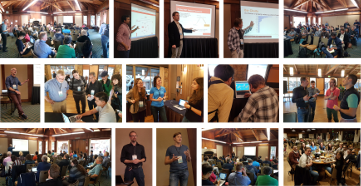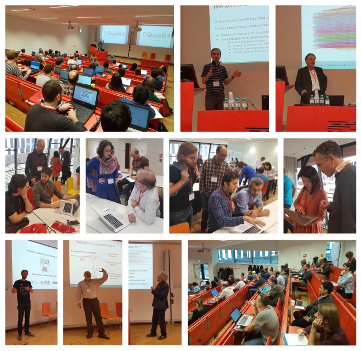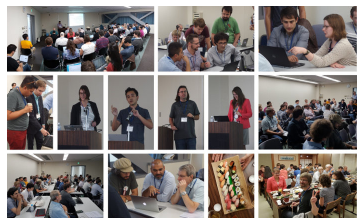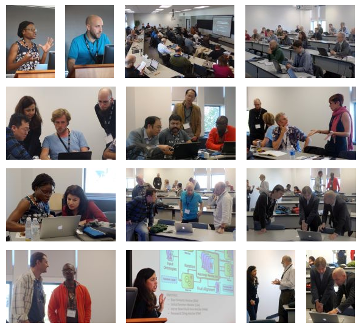Visualization and Interaction for Ontologies and Linked Data
6th International Workshop co-located with ISWC 2021, October 25, 2021, Virtual Workshop

Motivation and Objectives
A picture is worth a thousand words, we often say, yet many areas are in demand of sophisticated visualization techniques, and the Semantic Web is not an exception. The size and complexity of ontologies and Linked Data in the Semantic Web constantly grows and the diverse backgrounds of the users and application areas multiply at the same time. Providing users with visual representations and intuitive interaction techniques can significantly aid the exploration and understanding of the domains and knowledge represented by ontologies and Linked Data.
Ontology visualization is not a new topic and a number of approaches have become available in recent years, with some being already well-established, particularly in the field of ontology modeling. In other areas of ontology engineering, such as ontology alignment and debugging, although several tools have been developed, few provide a graphical user interface, not to mention navigational aids or comprehensive visualization and interaction techniques.
In the presence of a huge network of interconnected resources, one of the challenges faced by the Linked Data community is the visualization of multidimensional datasets to provide for efficient overview, exploration and querying tasks, to mention just a few. With the focus shifting from a Web of Documents to a Web of Data, changes in the interaction paradigms are in demand as well. Novel approaches also need to take into consideration the technological challenges and opportunities given by new interaction contexts, ranging from mobile, touch, and gesture interaction to visualizations on large displays, and encompassing highly responsive web applications.
There is no one-size-fits-all solution but different use cases demand different visualization and interaction techniques. Ultimately, providing better user interfaces, visual representations and interaction techniques will foster user engagement and likely lead to higher quality results in different applications employing ontologies and proliferate the consumption of Linked Data.
Program
The workshop will take place online on October 25th 12:00 - 15:00 CEST
(link provided by ISWC to registered participants).
Proceedings available here.
12:00 - 12:05 Opening and Introduction
12:05 - 13:25 Session I: Linked data - SPARQL
by Mariana Aguiar, Sérgio Nunes and Bruno Giesteira
12:20 - 12:35 Fast Approximate Autocompletion for SPARQL Query Builders
by Gabriel de la Parra and Aidan Hogan
12:35 - 12:50 Displaying triple provenance with extensions of Fresnel
by Lloyd Rutledge, Pascal Mellema, Tije Pietersma and Stef Joosten
12:50 - 13:05 Visual Presentation of SPARQL Queries in ViziQuer
by Kārlis Čerāns, Julija Ovcinnikova, Mikus Grasmanis, Lelde Lace and Aiga Romane
13:05 - 13:15 VizKG: A Framework for Visualizing SPARQL Query Results over Knowledge Graphs
by Hana Raissya, Fariz Darari and Fajar J. Ekaputra
13:15 - 13:25 Discussion
13:40 - 15:00 Session II
by Thibault Ehrhart, Pasquale Lisena and Raphaël Troncy
13:55 - 14:05 Timelining Knowledge Graphs in the Browser
by Damien Graux, Fabrizio Orlandi, Tanmay Kaushik, David Kavanagh, Hailing Jiang, Brian Bredican, Matthew Grouse and Dáithí Geary
by Ana Guerreiro, Catia Pesquita and Daniel Faria
14:20 - 14:35 A First Step towards a Tool for Extending Ontologies
by Mina Abd Nikooie Pour, Huanyu Li, Rickard Armiento and Patrick Lambrix
14:35 - 14:45 RepOSE-CTab - A Protégé Plugin for Completing Ontologies
by Zlatan Dragisic, Ying Li and Patrick Lambrix
Topics of Interest
Topics, subjects, and contexts of interest include (but are not limited to):
- Topics:
- visualizations
- user interfaces
- visual analytics
- requirements analysis
- case studies
- user evaluations
- cognitive aspects
- Subjects:
- ontologies
- linked data
- knowledge graphs
- ontology engineering
- Contexts:
- classical interaction contexts (desktop, keyboard, mouse, etc.)
- modern interaction contexts (mobile, touch, gesture, speech, etc.)
- special settings (large, high-resolution, and multiple displays, etc.)
- specific user groups and needs (people with disabilities, domain experts, etc.)
Submission Guidelines
Paper submission and reviewing for this workshop are organized via EasyChair. The papers should be written in English, following the Springer LNCS format, and be submitted in either PDF or in HTML on or before July 26, 2021. Abstracts are due on or before July 12, 2021.
All deadlines are midnight Hawaii time.
For details on the PDF submission format, see Springer's LNCS guidelines. For HTML submission guidance, see the HTML submission guide of ISWC 2021.
The following types of contributions are welcome. The recommended page length is given in brackets. There is no strict page limit but the length of a paper should be commensurate with its contribution.
- Full research papers (8-12 pages);
- Experience papers (8-12 pages);
- Position papers (6-8 pages);
- Short research papers (4-6 pages);
- System papers (4-6 pages).
It is recommended to include a (persistent) URI to a working implementation or an (annotated) screencast for submissions presenting interactive visualizations, user interfaces, tools, etc.
Accepted papers will be published as a volume in the CEUR Workshop Proceedings series, as in previous years.
For details concerning the conference and/or workshop registration, please refer to the ISWC registration page.
Organizers
Patrick Lambrix, Linköping University, Sweden
Vitalis Wiens, L3S, TIB, & Leibniz University Hanover, Germany
Programme Committee
Anastasia Dimou, Ghent University
Roberto García, Universitat de Lleida
Alain Giboin, INRIA
Anika Groß, University of Leipzig, Germany
Ali Hasnain, Royal College of Surgeons Ireland, University of Medicine and Health Sciences
Emmanuel Pietriga, INRIA
Harald Sack, FIZ Karlsruhe, Leibniz Institute for Information Infrastructure & KIT Karlsruhe
Daniel Schwabe, Dept. of Informatics, PUC-Rio
Kamran Sedig, University of Western Ontario
Ahmet Soylu, Norwegian University of Science and Technology
Markel Vigo, The University of Manchester
Kārlis Čerāns, University of Latvia, Latvia
Sponsors
Important Dates
- Abstract:
July 12, 2021 - Submission:
July 26, 2021 - Notification:
August 27, 2021 - Camera-ready:
September 24, 2021> - Workshop: October 25, 2021





